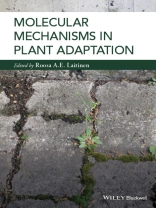Plants are forced to adapt for a variety of reasons– protection, reproductive viability, and environmental and climatic changes. Computational tools and molecular advances have provided researchers with significant new insights into the molecular basis of plant adaptation. Molecular Mechanisms in Plant Adaptation provides a comprehensive overview of a wide variety of these different mechanisms underlying adaptation to these challenges to plant survival.
Molecular Mechanisms in Plant Adaptation opens with a chapter that explores the latest technological advances used in plant adaptation research, providing readers with an overview of high-throughput technologies and their applications. The chapters that follow cover the latest developments on using natural variation to dissect genetic, epigenetic and metabolic responses of plant adaptation. Subsequent chapters describe plant responses to biotic and abiotic stressors and adaptive reproductive strategies. Emerging topics such as secondary metabolism, small RNA mediated regulation as well as cell type specific responses to stresses are given special precedence. The book ends with chapters introducing computational approaches to study adaptation and focusing on how to apply laboratory findings to field studies and breeding programs.
Molecular Mechanisms in Plant Adaptation interest plant molecular biologists and physiologists, plant stress biologists, plant geneticists and advanced plant biology students.
Tabla de materias
List of Contributors ix
Preface xiii
1 Technological Advances in Studies of Plant Adaptation 1
José G. Vallarino and Sonia Osorio
Introduction 1
Next-Generation Sequencing Technologies 2
Applications of Next-Generation Sequencing 7
Proteome Analysis in Understanding Plant Adaptation 12
Applications of Proteomics 16
Metabolome Analysis in Plant Adaptation 17
Applications of Metabolic Profiling 18
Concluding Remarks and Future Prospects 21
Acknowledgments 22
References 22
2 Use of Natural Variation in Arabidopsis thaliana to Study Adaptation 31
Lisa M. Smith and Roosa A. E. Laitinen
Introduction 31
Genetic Natural Variation 33
Epigenetic Natural Variation 37
Natural Variation and Metabolites 42
Use of A. thaliana Hybrids in Understanding Evolution 46
Conclusion 49
Acknowledgments 50
References 50
3 Seed Dormancy, Longevity and Their Adaptation 61
Thu-Phuong Nguyen and Leónie Bentsink
Introduction 61
The Induction of Seed Dormancy and Seed Longevity 62
Factors Affecting Seed Dormancy and Seed Longevity 63
Seed Dry Storage 64
Genetics of Seed Dormancy and Seed Longevity 67
The Relation Between Seed Dormancy and Seed Longevity and its Ecological Significance 70
Ecological Role 70
The Trade-off Between Seed Dormancy and Seed Longevity 73
Conclusions 74
References 74
4 The ‘Gatekeeper’ Concept: Cell-Type Specific Molecular Mechanisms of Plant Adaptation to Abiotic Stress 83
Sam W. Henderson and Matthew Gilliham
Introduction 83
The ‘Gatekeeper’ Concept 85
Single Cell Types Within Plant Roots 86
Root Hairs – Tolerance to Phosphorus Deficiency 88
Epidermal Cells of the Root Apex – Aluminum Tolerance 91
Xylem Parenchyma Cells – Salinity Tolerance 94
Pericycle Cells – Nitrogen Starvation 99
Endodermal Cells – ABA Signaling Under Abiotic Stress 102
Beyond Gatekeepers – Conclusions and Perspectives 103
References 105
5 Regulatory and Biosynthetic Mechanisms Underlying Plant Chemical Defense Responses to Biotic Stresses 117
William R. Chezem and Nicole K. Clay
Introduction 117
Defensive Phenylpropanoids 119
Defense-Related Regulators of Phenylpropanoid Metabolism 124
Defensive Aromatic Alkaloids 126
Defense-Related Regulators of Aromatic Alkaloid Metabolism 131
Conclusion 134
References 135
6 Role of Small RNAs in Regulation of Plant Responses to Stress 147
Luis A.A. Toledo-Filho and Sascha Laubinger
Introduction 147
mi RNAs Biogenesis and Function 148
Evolution of mi RNAs 149
si RNAs Biogenesis and Function 150
s RNA Stress Responses 151
s RNA in Abiotic Stress Responses 157
Conclusions and Future Prospects 162
References 163
7 Adaptation of Flower Form: An Evo-Devo Approach to Study Adaptive Evolution in Flower Morphology 169
Roxana Yockteng, Ana M.R. Almeida, Alma Pi ~neyro-Nelson, and Chelsea D. Specht
Introduction 169
Flower Developmental Genetics: (A)BCs and Beyond 171
Approaches to the Study of Evolution of Floral Morphology 172
Using GRNs to Investigate Adaptive Evolution of Floral Form: SEP3 as a Case Study 176
Conclusions 184
Acknowledgments 185
References 185
8 Computational Approaches to Dissect and Understand Mechanisms of Adaptation 191
Sabrina Kleessen and Zoran Nikoloski
Introduction 191
Experimental Set-Ups for Data Acquisition to Reveal
Trade-Offs via Correlations 193
Pareto Front Approaches 195
The Triangulation Criterion 195
Ranking of Genotypes 197
From Models to Elements Contributing to Adaptation 199
Cellular Tasks Involved in Adaptation 202
Minimal Network Adjustments Upon Perturbations 202
Investigation of Network Adjustments by Integrating
High-Throughput Data 204
Non-Steady State Behavior and Metabolic Network
Adjustments 205
Future Challenges and Perspectives 207
References 208
9 From the Greenhouse to the Real World – Arabidopsis Field Trials and Applications 215
Karin Köhl and Roosa A.E. Laitinen
Introduction 215
Field Experiments in A. thaliana 216
How to do Field Trials? 220
From Arabidopsis to Crops 228
Future Prospects 230
References 230
Index 235
Sobre el autor
Roosa Laitinen is the Research Group Leader of Molecular Mechanisms of Adaptation at the Max Planck Institute of Molecular Plant Physiology. Dr. Laitinen has published widely in the area of plant adaptation in publications including Nature, Plant Physiology, and Journal of Experimental Biology.












